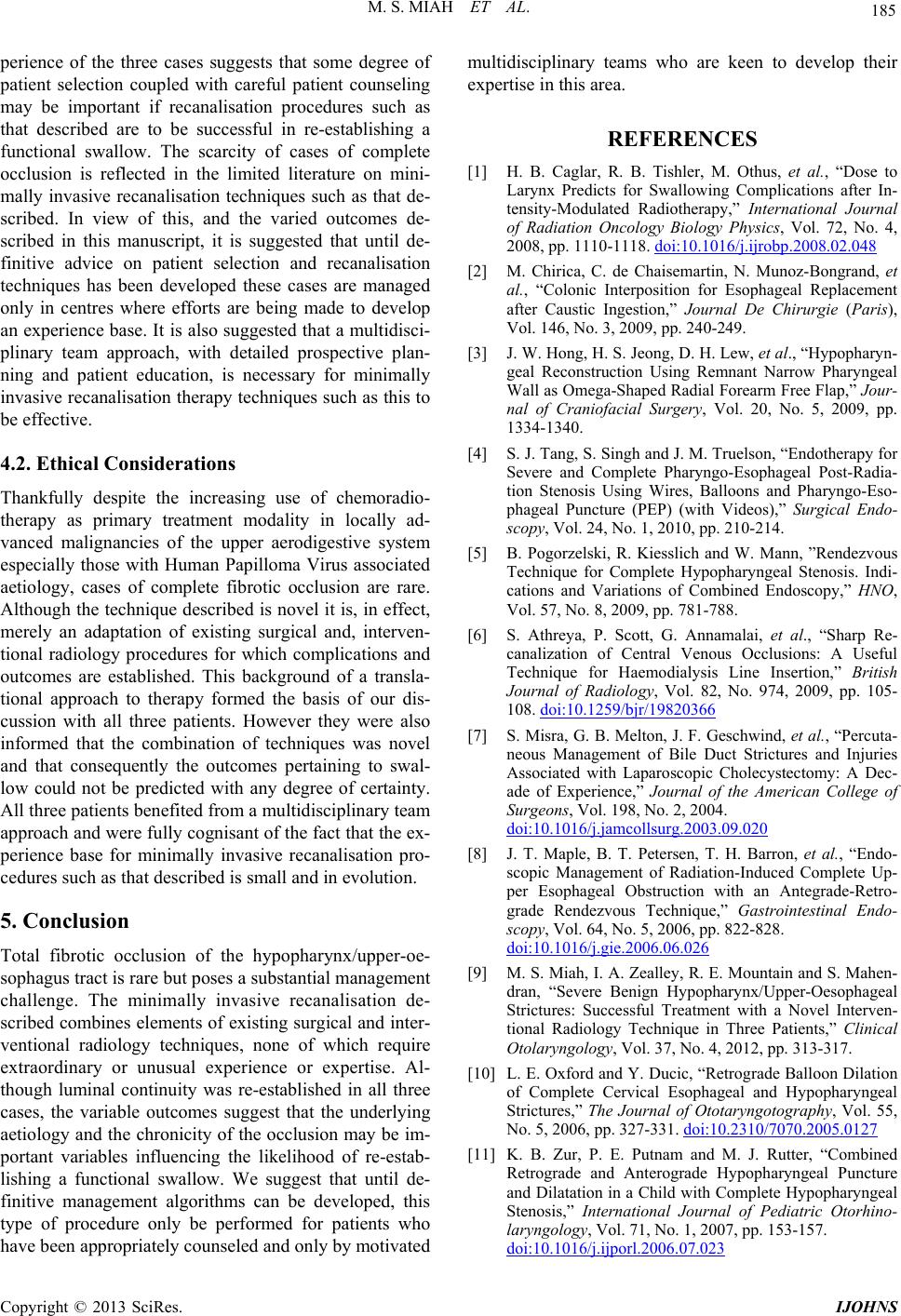
M. S. MIAH ET AL.
Copyright © 2013 SciRes. IJOHNS
185
perience of the three cases suggests that some degree of
patient selection coupled with careful patient counseling
may be important if recanalisation procedures such as
that described are to be successful in re-establishing a
functional swallow. The scarcity of cases of complete
occlusion is reflected in the limited literature on mini-
mally invasive recanalisation techniques such as that de-
scribed. In view of this, and the varied outcomes de-
scribed in this manuscript, it is suggested that until de-
finitive advice on patient selection and recanalisation
techniques has been developed these cases are managed
only in centres where efforts are being made to develop
an experience base. It is also suggested that a multidisci-
plinary team approach, with detailed prospective plan-
ning and patient education, is necessary for minimally
invasive recanalisation therapy techniques such as this to
be effective.
4.2. Ethical Considerations
Thankfully despite the increasing use of chemoradio-
therapy as primary treatment modality in locally ad-
vanced malignancies of the upper aerodigestive system
especially those with Human Papilloma Virus associated
aetiology, cases of complete fibrotic occlusion are rare.
Although the technique described is novel it is, in effect,
merely an adaptation of existing surgical and, interven-
tional radiology procedures for which complications and
outcomes are established. This background of a transla-
tional approach to therapy formed the basis of our dis-
cussion with all three patients. However they were also
informed that the combination of techniques was novel
and that consequently the outcomes pertaining to swal-
low could not be predicted with any degree of certainty.
All three patients benefited from a multidisciplinary team
approach and w ere fully co gnisant of the fact that the ex-
perience base for minimally invasive recanalisation pro-
cedures such as that described is small and in evolution.
5. Conclusion
Total fibrotic occlusion of the hypopharynx/upper-oe-
sophagus tract is rare but poses a substantial man ag ement
challenge. The minimally invasive recanalisation de-
scribed combines elements of existing surgical and inter-
ventional radiology techniques, none of which require
extraordinary or unusual experience or expertise. Al-
though luminal continuity was re-established in all three
cases, the variable outcomes suggest that the underlying
aetiology and the chronicity of the occlusion may be im-
portant variables influencing the likelihood of re-estab-
lishing a functional swallow. We suggest that until de-
finitive management algorithms can be developed, this
type of procedure only be performed for patients who
ave been appropriately counseled and only by motivated
multidisciplinary teams who are keen to develop their
expertise in this area.
h
REFERENCES
[1] H. B. Caglar, R. B. Tishler, M. Othus, et al., “Dose to
Larynx Predicts for Swallowing Complications after In-
tensity-Modulated Radiotherapy,” International Journal
of Radiation Oncology Biology Physics, Vol. 72, No. 4,
2008, pp. 1110-1118. doi:10.1016/j.ijrobp.2008.02.048
[2] M. Chirica, C. de Chaisemartin, N. Munoz-Bongrand, et
al., “Colonic Interposition for Esophageal Replacement
after Caustic Ingestion,” Journal De Chirurgie (Paris),
Vol. 146, No. 3, 2009, pp. 240-249.
[3] J. W. Hong, H. S. Jeong, D. H. Lew, et al., “Hypopharyn-
geal Reconstruction Using Remnant Narrow Pharyngeal
Wall as Omega-Shaped Radial Forearm Free Flap,” Jour-
nal of Craniofacial Surgery, Vol. 20, No. 5, 2009, pp.
1334-1340.
[4] S. J. Tang, S. Singh and J. M. Truelson, “Endotherapy for
Severe and Complete Pharyngo-Esophageal Post-Radia-
tion Stenosis Using Wires, Balloons and Pharyngo-Eso-
phageal Puncture (PEP) (with Videos),” Surgical Endo-
scopy, Vol. 24, No. 1, 2010, pp. 210-214.
[5] B. Pogorzelski, R. Kiesslich and W. Mann, ”Rendezvous
Technique for Complete Hypopharyngeal Stenosis. Indi-
cations and Variations of Combined Endoscopy,” HNO,
Vol. 57, No. 8, 2009, pp. 781-788.
[6] S. Athreya, P. Scott, G. Annamalai, et al., “Sharp Re-
canalization of Central Venous Occlusions: A Useful
Technique for Haemodialysis Line Insertion,” British
Journal of Radiology, Vol. 82, No. 974, 2009, pp. 105-
108. doi:10.1259/bjr/19820366
[7] S. Misra, G. B. Melton, J. F. Geschwind, et al., “Percuta-
neous Management of Bile Duct Strictures and Injuries
Associated with Laparoscopic Cholecystectomy: A Dec-
ade of Experience,” Journal of the American College of
Surgeons, Vol. 198, No. 2, 2004.
doi:10.1016/j.jamcollsurg.2003.09.020
[8] J. T. Maple, B. T. Petersen, T. H. Barron, et al., “Endo-
scopic Management of Radiation-Induced Complete Up-
per Esophageal Obstruction with an Antegrade-Retro-
grade Rendezvous Technique,” Gastrointestinal Endo-
scopy, Vol. 64, No. 5, 2006, pp. 822-828.
doi:10.1016/j.gie.2006.06.026
[9] M. S. Miah, I. A. Zealley, R. E. Mountain and S. Mahen-
dran, “Severe Benign Hypopharynx/Upper-Oesophageal
Strictures: Successful Treatment with a Novel Interven-
tional Radiology Technique in Three Patients,” Clinical
Otolaryngology, Vol. 37, No. 4, 2012, pp. 313-317.
[10] L. E. Oxford and Y. Ducic, “Retrograde Balloon Dilation
of Complete Cervical Esophageal and Hypopharyngeal
Strictures,” The Journal of Ototaryngotography, Vol. 55,
No. 5, 2006, pp. 327-331. doi:10.2310/7070.2005.0127
[11] K. B. Zur, P. E. Putnam and M. J. Rutter, “Combined
Retrograde and Anterograde Hypopharyngeal Puncture
and Dilatation in a Child with Complete Hypopharyngeal
Stenosis,” International Journal of Pediatric Otorhino-
laryngology, Vol. 71, No. 1, 2007, pp. 153-157.
doi:10.1016/j.ijporl.2006.07.023